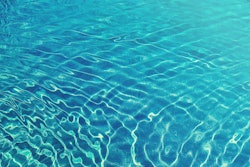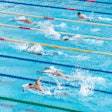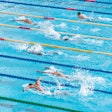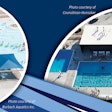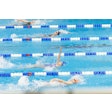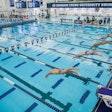Building a dedicated pool is beyond the wherewithal of most swim clubs, and yet some organizations manage to get it done.

But "Coach Mike," as he sometimes appears on the web site of Nitro Swimming - he is, in fact, the proprietor of the Cedar Park, Texas, swim club - must have done some things right, too. In June, the 42-year-old former All-American swimmer from Oakland University opened the doors to the 31,000-square-foot, $4.5 million Nitro Swim Center, the centerpiece of which is a 50-meter pool with 23 long-course and 10 short-course lanes for training, lessons and small competitions. The facility also has a four-lane, warm-water pool for aquatic therapy and teaching, an 800-square-foot fitness center to keep parents occupied, and locker rooms. A tiny space serves as a child-care area; the center's architect, SLR Design of nearby Austin, had intended this to be a janitor's closet, but Koleber instead specified a window and kids' furnishings. "I'll put the yellow bucket and mop in the pump room," he says.
The Nitro Swim Center is among the first tangible results of USA Swimming's heightened focus on getting pools built. Since the organization began running its annual Build a Pool Facilities Conference three years ago, 15 new aquatic centers have opened - not a huge number, but welcome all the same given the nation's gradual loss of aquatic facilities to old age and financial distress.
"We're losing pools right and left," says Mick Nelson, USA Swimming's club facilities development director. "Cities are saying they can't afford them anymore."
The vast majority of the 2,800 USA Swimming clubs - fully 93 percent - lease time from a variety of existing facilities, and the 15 newest pools reflect the importance of partnerships to keeping swim clubs afloat. "There's one owned by a park district, two by health clubs, two by private groups, one by a junior college, two by hospitals, one by an NCAA Division III school - I can't say there's one standard model," says Nelson. "It depends on who wants to do what, who partners with whom, and who the shaker is locally to get the project done. Somebody has to sell it and be willing to head up the project. It doesn't matter who the person with vision is, it just has to be somebody who really wants to spend the time to make sure it is a success."
Koleber's pool journey took five years; about one year into it, someone suggested to him that it would be a lot quicker and easier if he'd just partner with the local YMCA. "I didn't want that; I know how the Y operates," he says. "They get you to pay for the pool, and then they run their own programs. I have also seen school districts that are running multiple swim programs, and there's just too much conflict. Everyone has different ideas of what they need. Going it alone cost us maybe three years, but what we get out of it is autonomy."
Going it alone also costs money - more money than most swim clubs have at the ready. When all was said and done, Koleber raised a little more than $900,000 from a dozen investors, and took out a Small Business Administration loan of $1.5 million and a standard loan from a local bank for the remaining $2.1 million.
Swim clubs such as Hilton Head (S.C.) Aquatics, with its approximately 100 members, can't fathom such figures. Neither, apparently, could the Hilton Head Parks and Recreation Commission.
"Five years ago, somebody went to the town with a proposal to do a $6 million, 50-meter pool, and they looked at him as if to say, 'What are you thinking?' " says Hilton Head Aquatics board president Carol Hammond. Though the town had identified a new aquatic center as a need in its long-term recreation plan, a 2004 proposal fell apart over financial and jurisdictional issues, and the swim club's more recent efforts have hit similar roadblocks. "They cautioned us to not come back to them with that kind of proposal," Hammond says. "It's kind of a political quagmire."
The swim club has leased time at the park district's Island Recreation Center 25-yard pool for more than 20 years, but Hammond says as that facility gets older, swim club members fear that a sudden breakdown in its infrastructure would leave swimmers high and dry. The thinking is that a new facility would offer an opportunity to get the club a more desirable 50-meter tank for the further development of its more elite competitors, but city officials aren't convinced that such a pool would serve the greater good. As for now, the park district and swim club are working to develop a more palatable proposal. "We're really in limbo," Hammond says.
The situation is even more dire in Piedmont, Calif., where the Piedmont Swim Club's lease on the facility it helped build in 1964 and has operated ever since is due to expire in June 2008. While the club has asked the city to extend the lease for five years, the city is currently considering a number of options, including building a new aquatic center or assuming operations of the existing facility. "Currently" is perhaps not the best word; as former Piedmont mayor Al Peters told the Contra Costa Times last year, "We have gone through four mayors discussing this plan."
The uncertainty surrounding its future is partly responsible for a dip in the club's memberships to about 500, too low a number to allow the club to break even after paying its $70,000 rent to the city. In addition, the club has begun putting repairs on the back burner until operators are certain that they'll have a home to repair.
"Why do all the improvements with only one year left on the lease?" Paul Schroeder, the swim club's board president, asks. "When you're renting, you do the minimum. You do what's needed, but you don't plan for the future because you don't know how long the future is. We want to continue to sell memberships now, but all we can offer is a one-year membership because after that, we might not be around."
Ron Frederick, board president of the Dayton (Ohio) Raiders swim club, says his 160-member group is tired of renting pools - to be more specific, tired of renting seven different pools around the city, including a county-owned, outdoor 50-meter pool the club uses during the summer, two YMCA pools, the aquatic center at Wright State University, two private pools and an old Boys & Girls Club pool.
"We're all over town, with the kids, the parents and the coaches traveling to many different parts of town to get the whole team to practice on any given evening," Frederick says. "It's costly, sometimes there's an issue with lane availability - there are a lot of complications."
The club has therefore been in the market for a five-acre site on which it would construct a shared aquatic center - but shared with whom? Some of the land the club has looked at is also being considered by the school district for possible new buildings, and several meetings have been held in which no definitive agreement has been struck or timetable suggested. Frederick has also spoken with two local hospitals over the past few years, as well as the county.
"We certainly could not raise the money necessary to build a pool, and we're counting on donated land," Frederick says. "It's not an easy sell, that's for sure. We've been talking about this for at least five years - I started when my kids were young, and they'll all be out of college by the time we get it done."
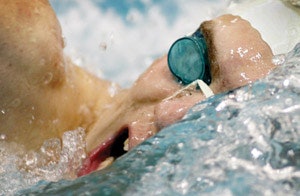
USA Swimming's Nelson completed his first facility - a six-lane, 25-yard pool and a four-lane, 20-yard teaching pool - in time for New Year's Day, 1972. "It was 13,000 square feet, with showers and offices, and I built the whole facility for $680,000. That facility right now would cost $4 million," says Nelson. "I remember my first electric bill was $835. When I sold the business three years ago, the bill was running about $11,000 for the same units. You really need a good business plan to be successful."
Koleber knows he did well to get his pool for as little as he did. (Most knowledgeable industry sources put the floor for a 50-meter pool at $6 million.) But that's small consolation as he enters this new phase of his business knowing he has two banks and 12 investors to pay back over the next 20 years. "To do what we need to do, the number of swimmers we have to run through here is just massive, and you can't just run them all through from 4 to 7 p.m.," Koleber says.
By the time he attended the Build a Pool Facilities Conference, Koleber was already on the verge of putting the first shovel in the ground, so he could have been forgiven for swallowing hard when he heard industry professionals recommend 25-yard rather than 50-meter pools. USA Swimming's take on this is that the large tank makes it more difficult to accommodate separate teaching activities when swimmers are not practicing long-course swimming. The general assumption, too, is that with limited funds, most swimming organizations are better off sinking their money into smaller, separate bodies of water.
"We try to make the point that competitive swimming doesn't build or support a facility unless it's in cooperation with other aquatic disciplines - it has to be total aquatic programming, or you haven't got a chance," Nelson says. "Pool operators have to handle the four pillars of aquatics, which are community lessons, competitive events, aquatic exercise and rehab/therapy. They don't necessarily have to offer all four, but they're silly if they don't explore all possibilities."
One of the things Koleber heard at the conference was that even swim clubs that had their own pools - including Nelson's facility - typically rented other pools to run meets. Koleber understands the logic - meets in which hundreds of outsiders converge on your pool can mean physical damage to your facility and inconvenience to your regular members. In the case of the Nitro Swim Center, parking is limited, so any meets Koleber runs will be for his regular swimmers only, and even then he may split the meets up so that he can keep more-lucrative activities going in the teaching pool at all times.
Koleber is drawing from a group of 380 registered swimmers with the Nitro program, plus almost 400 swimmers who have registered for the center's first summer league and another 250 who have pre-registered for lessons. The money will come from many sources, but Koleber notes that lessons offer the greatest potential. "I'm making $98 an hour on each group of four swimmers, and I've got room for lots of groups of four," he says. "So, where should my emphasis be?"
Another revenue source that Koleber hadn't counted on is breakout clinics offered by USA Swimming in partnership with the Mutual of Omaha insurance company. For these four-hour clinics, USA Swimming brings in an Olympian to swim, offer teaching tips, pose for photos and sign various giveaways, charging $50 a person and keeping the ticket revenue from the first 70 sold. "Can we get 150 kids to come? Absolutely," Koleber says. "If I can get 200 kids, I take in $6,500 for a half-day."
In her pitch to Hilton Head recreation commissioners for a 50-meter pool, Hammond mentioned lap swimmers, of course, but also triathletes in training, competitive swimmers, resort visitors and even kayakers as people who would be interested in the bigger pool. "There are not that many people who need that kind of water," she concedes, "but we were thinking of it as one-stop shopping."
Koleber has considered all of those groups, plus others that might fill the pool during traditional off-hours: Home-school students, retirees, rehab patients and high school teams (the Round Rock district athletic director, with whom Koleber has had several substantive conversations, is looking to snatch up the 7 to 9 a.m. time slot for training). In addition, the pool depth was specified from 4 to 8 feet, with the deeper area meant to accommodate water polo, scuba certification and synchronized swimming. "Those users weren't part of my pitch to the bank, but I wanted to be able to host them if I needed them," Koleber says. "Ideally, your business is like the multiplex - you know how there are 16 movies playing, but the lobby is always empty? You want all these activities staggered through the day, so that as people are leaving the parking lot, other people are pulling in. As long as you're generating dollars from those bodies in the water, the business side should work."
Unfortunately for most would-be aquatics entrepreneurs, bankers' goggles tend to fog up at this stage in the PowerPoint demonstration. "You present a great program to them - financials, a history of running a swim club behind you - but to the bank, a) you're a startup and, b) you're proposing what they think of as a single-use facility," Koleber says. "They think it's too risky; they're thinking, 'What's going to happen if this guy can't make this work? We'll be left with two holes in the ground and a bunch of equipment we can't use.' "
Naturally enough, what convinces a bank, Koleber says, is money. Raising money up front before speaking to a bank about a loan demonstrates your desire and people's belief in the project. Raising more than you think you need, Koleber notes, is vital, since you'll inevitably need more than you think. In his case, having settled on a $700,000 target (20 percent of the total needed for construction), Koleber spent three years raising it - during which time the cost of construction went up considerably. "Now you've got to go back to your investors and ask, 'Anybody want to give extra?' " he says.
Koleber's first investor, typically the hardest to convince, ended up making three investments totaling $570,000 of the $909,000 raised. Others included a handful of swim-club families, as well as Koleber, his wife and his parents. With everything on the line, Koleber says he was extra careful to make sure his business plan's projections were achievable.
"I underestimated revenues and overestimated expenses - I only counted what I knew I could do blindfolded and walking backwards," he says. "If I didn't feel comfortable with my numbers, I wouldn't do the deal, because I pretty much signed away my life to build this pool."



















